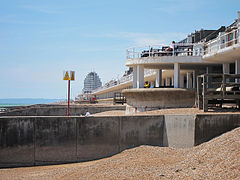Sidney Little
Sidney Little, MICE (1885–1961) was a British civil engineer. He was born in Carlisle and after working in Ipswich as the Borough Engineer he was appointed in 1926 in Hastings, East Sussex as the Borough and Water Engineer, later including the role of Borough Planning Officer. He worked there for 24 years. During that time, he was responsible for implementing a number of major projects in the town.
Career

Known on the South Coast of England as "The Concrete King",[1] Little had great knowledge of reinforced concrete. Many of his projects used this material. Improvements to the "Front Line" sea defences allowed the creation of the UK's first underground car parks. A covered 1,500 ft (455 metres) promenade between Hastings Pier and Warrior Square, completed in April 1934 as part of the town's sea defences, was created using concrete panels containing thousands of coloured glass fragments for decoration. This became known locally as "Bottle Alley". Other concrete projects included the construction of a large open air bathing pool at West St Leonard's[2] with a set of double decker seaside chalets in concrete. The White Rock Baths[3] were reconstructed along with several other municipal projects such as the conversion of Johns Place into a museum and plans for an aerodrome at Pebsham near St Leonards on Sea, UK.

Little was unpopular with some people because of his willingness to remove historic buildings for road creation schemes, but his most important work was with the water supply to the town of Hastings and St Leonard's with the construction of deep tunneled aqueducts up to 200 ft deep and the construction of Powdermill, Darwell and Baldslow reservoirs to supply water. Little also contributed to the improvement and provision of sewers throughout Hastings.
Between 1940 and 1944, Little's expertise was used by the Ministry of Defence when he worked with the Admiralty on the creation of huge concrete Mulberry Harbour floats that were used for the D Day landings. He designed aboveground sea front shelters constructed from reinforced concrete. The structures were towed to France and linked to form harbour walls. They helped the Allies to take ashore large numbers of vehicles, personnel, communications equipment and other supplies – vital to sustaining the frontline forces as they pushed deeper into German territory.[4]
Sidney Little M.I.C.E. was granted freedom of the Borough of Hastings in 1960, and died in 1961 at age 76.
References
- ^ "The Concrete King's million gallon masterpiece – Hastings In Focus". Retrieved 22 June 2022.
- ^ "The Concrete King's million gallon masterpiece – Hastings In Focus". Retrieved 22 June 2022.
- ^ June 18, Anne Green Jessel /; SOUTH, 2014 / Leave a comment / (18 June 2014). "Hastings White Rock Baths - 1876. Under the Promenade". Finding Lidos - Dive into Lost Lidos. Retrieved 22 June 2022.
{{cite web}}: CS1 maint: numeric names: authors list (link) - ^ "The 'Mulberry' wartime secret - History Points". historypoints.org. Retrieved 22 June 2022.
